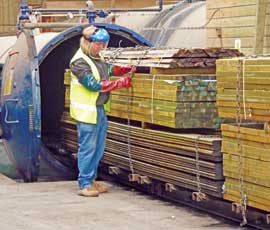Stopping the rot when it comes to fence posts

The problem stems from an EU-wide ban in 2004, prohibiting the use of the old chromated copper arsenate (CCA) wood treatment on health grounds. Instead, wood treatment companies had to develop alternative treatments, which vary greatly in their formulation and efficacy.
“CCA products were very generic in their formulation, but the new generation preservatives are very different to each other, and some give better performance than others,” says David Law, marketing services manager at Arch Timber Protection. Farmers should therefore seek out a product that has proven performance in the field.
However, it is not just the choice of preservative that is important. Timber species, moisture content, the treatment process, and final handling at installation all have a critical role to play.
What timber should I use?
The most common species grown in the UK are spruce, which is a white wood, and pine, Douglas Fir and larch, which are all redwoods. “It is better to choose redwoods as the preservative penetrates deeper into the timber,” says Mr Law. The wood should be dried to about 28% moisture, although that varies according to species. Timber which is not sufficiently dry will not absorb the preservative correctly. Although some manufacturers kiln dry timber posts, air drying, if done correctly, is better as the wood is less likely to become brittle.
How is it treated?
The timber is put into a pressurised chamber, which forces the preservative deep into the wood structure. The resulting timbers have a distinctive pale green colouration when freshly treated. Although “tanalised” has become a generic term for green treated timber, is it only wood treated with Tanalith E that can be branded as Tanalised, as other treatments may not deliver the same protection.
The preservative should penetrate evenly to at least 6mm depth, says Emma Delbridge, sales manager at Cornwall-based Bond Timber. “Your supplier should be happy to demonstrate the level of preservative penetration by cutting across a sample fence post.”
How long will it last?
There are different treatment cycles for different wood uses, ranging from internal structures at one end to Highways Agency uses at the other. Timbers that are suitable for in-ground use like fence posts must be treated to a minimum British Standard use class four, which should give a useful service life of about 15 years. Farmers wanting timbers to last 30 years should opt for the Highways Agency gold standard – use class five.
Should I continue to treat the fence to lengthen its lifespan?
Because the preservative is embedded deep in the timber cells, it remains there for the lifetime of the fence, says Miss Delbridge. “Very little benefit will be achieved by trying to add subsequent brush-on products to extend the service life of the timber.
“What is important is that during installation of the fence any cuts or notches are swabbed with Ensele – a brush-on preservative to maintain the integrity of the treatment.” Without this, water and insects can easily attack the timber at the untreated site. If posts need to be shortened, the cut end should always remain on top, and not be used in contact with the ground.
How do I know my timber merchant is doing the job correctly?
The UK Wood Protection Association is developing a BenchMark assurance scheme for timber merchants. Find a reliable merchant, ask what type of timber they use, how dry it is, and what preservative they use. And don’t just buy on price – if you want top quality timber don’t buy the cheapest fencing you can get.

